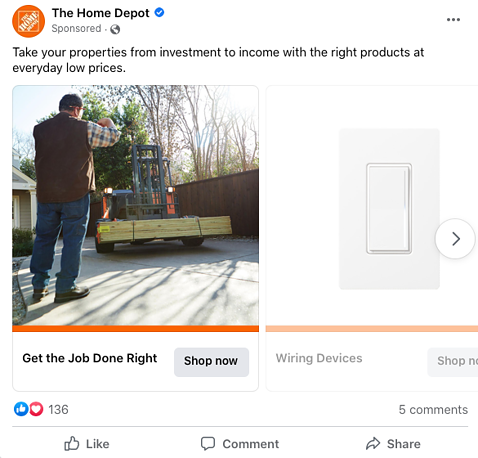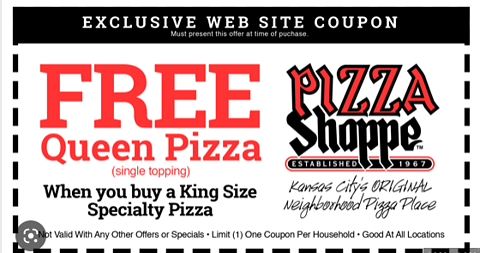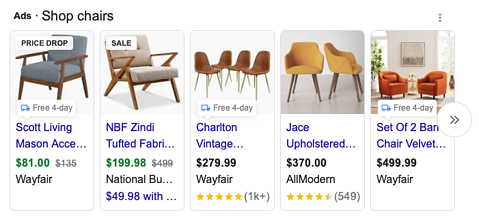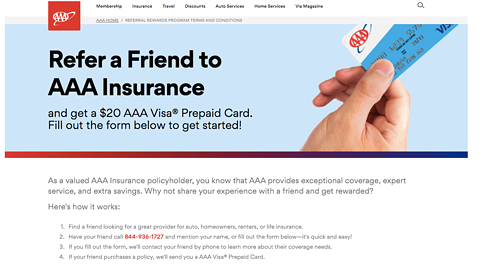Today’s consumers have an almost limitless amount of information at their fingertips. Podcasts, videos, blog posts, and social media – are just a few of the sources that can drive them toward one brand over another.
If it’s your job to attract these potential customers, you know the struggles of generating high-quality leads.
In this piece, we’ll take a closer look at lead generation, discussing the different types of leads you could attract and providing some strategies and examples for lead gen that you can put to use right away.
What Is Lead Generation?
Lead generation is a marketing process of capturing potential consumers who show interest in your product or service.
The goal is to connect with people early in the buying process, earn their trust and build a relationship so that, when they’re ready to make a purchase, they buy from you.
But lead generation also serves secondary objectives, including building brand awareness, collecting customer data, and fostering brand loyalty.
With this in mind, it’s important to remember that not everyone who visits your store or website is a lead.
That’s why successful lead gen goes after specific targets, using a variety of platforms and strategies including:
- Landing pages – Using a tracking pixel, landing pages collect information about visitors you can later use to target them for sales.
- Email – Email is a great lead generation tool because the recipients will have opted in, which means they’re already familiar with your brand.
- Social media – With unmatched opportunities for engagement, your social media accounts are a great way to encourage your targets to take action.
- Blogs – A great way to establish authority and provide value, blogs are also a great place to promote specific offers.
- Live events – When it comes to qualifying leads, live events are a great way to meet your target audience and quickly identify the ones more likely to make a purchase.
- Coupons and other promotions – Offering a discount or free item is a great way to encourage targets to provide their contact information.
What will ultimately work best for you will depend on your niche and your audience.
As you experiment with different lead generation strategies, you may find one more successful than the others. This means you should probably make that channel your priority, whereas others may not be of any use at all.
But we’ll get to all that later.
First, let’s talk about leads.
[B2B Lead Generation] Download the free ebook →
The Different Types Of Leads
Sales is the engine that drives any business. Without sales, there’s no revenue. Without revenue, there’s no business. So, it’s kind of important.
But it’s a massive field. The approach a medical monitoring sensor salesperson takes is going to be very different from a used car salesman.
But both of them – and every other sales professional for that matter – have one thing in common: they need to spend most of their time pursuing the people who are most likely to buy.
In general, leads fall into seven categories:
- Hot Leads – These leads are ready to convert. They are qualified and interested in your offering, and are the most likely to convert to a sale. For example, this might be the purchasing director who has had several conversations with you and received a product demo. They have purchasing authority and a timeline.
- Cold Leads – These are potential customers who may be unfamiliar with your brand or offering. As of yet, they have shown no interest in what you’re selling. Generally speaking, these are the hardest leads to convert to sales.
- Warm Leads – A middle ground between the two previous types of leads, these are people who are familiar with who you are and what you offer. They’re the type who watch your videos or read your blogs, but haven’t contacted you directly. Your goal is to warm them up into hot leads.
- Information Qualified Leads (IQLs) – This is the kind of lead who has already shown some interest in your company and has followed a call to action. Maybe they signed up for your email newsletter or filled out a lead generation form. They are often looking for more information and will react positively to a nurturing campaign.
- Marketing Qualified Leads (MQLs) – MQLs are one step further down the pipeline from IQLs. They are actively searching for a solution that fits their needs, and are trying to discover if yours is the right fit. These are the types of leads who will download your whitepapers, watch your videos, and attend your corporate seminars.
- Sales Ready Leads (SRLs) – Sometimes called “accepted leads,” these are the bottom-of-the-funnel leads who are almost ready to pull the trigger on a purchase. It’s important to understand their budgets, purchasing authority, needs, and timeframe.
- Sales Qualified Leads (SQLs) – These leads are ready to buy and should be in communication with your sales team. They are considered very hot, however, you should be aware that they are likely still considering some of your competitors.
The Lead Generation Process
As you have probably gathered by this point, lead generation is a multiple-step process.
Yours will vary, depending on whether you’re focusing on inbound or outbound generation – but both should follow a similar pathway.
Step 1: Do Your Research
Before you start trying to collect leads, you need to gather as much information as possible about your target audience. You want to know not just who they are, but where they live, what’s important to them, and most importantly, what their pain points are, particularly those that are the most pressing.
It’s often a good idea to create customer personas, in which you define the demographics, budget, and needs of typical customers. You may want to consider social habits, professional experience, and even psychological traits.
Once you know who you’re going after, it’s time to identify where they are. Are they active on Facebook, or more likely to respond to an email? Again, this will vary depending on your specific circumstances.
This is also the stage where you should check out the competition. What are they doing? What differentiates your offering from theirs? And most importantly, why is it better?
Step 2: Create Great Content
By now, you should know what needs your offering fills for your potential customers. Use this information to create content that solves it.
Your choice of medium will affect your content format. For example, videos work great on social media, but you can’t embed them in an email.
Likewise, if you’re going after your target audience on Twitter, your lengthy blogs are going to need to be linked to, or at the very least truncated.
Never forget your focus is on adding value. Each piece of content you create should serve a specific purpose, whether that’s educating your audience about your offering, building brand awareness or promoting a sale.
Step 3: Develop A Lead Generation Database
You can have the hottest leads on the planet, but they won’t do you a bit of good if you don’t handle them the right way.
You should create and use a lead database where you can record, study, filter, and segment your potential customers.
Ideally, you’ll want to get an automated CRM system to dramatically reduce the labor involved with this.
Most of these will allow you to tag leads based on the type and how hot they are. This allows your sales team to work through their lists in a more efficient manner, dedicating the most attention to those with the biggest chance of converting.
Step 4: Qualify And Score Leads
Not all leads are going to be in the same place in the sales funnel. Some will be ready to buy today, while others may just be getting an idea of what’s out there.
You need to adjust your approach based on this.
Most companies use a lead scoring system of 1-100, which indicates approximately where the lead is in the customer journey. They are assigned points based on their actions, with more serious actions resulting in more points.
For example, following your Facebook page could be worth 10 points, filling out a “Request a demo” form might be worth 20, and opening and reading an email could be 5. If a lead does all three of these, their lead score would be 35.
These numbers will give you a general idea of where they are from the following stages:
- New leads, who have just made initial contact.
- Working leads, with whom you have had contact and initiated a conversation.
- Nurturing leads, who are not interested in buying right now, but might in the future.
- Unqualified leads, who are not interested in your offering. These are sometimes called “dead leads.”
- Qualified leads, or those who want to do business with you.
Obviously, you should focus more time and energy on the leads that have a higher probability of converting.
Lead Generation Strategies And Examples
The ways you can generate leads are practically endless, but in this section, we’ll discuss some of the more common strategies you can employ, plus give you examples of them at work.
Content Marketing
Content marketing is the practice of creating engaging and informative content that provides value for leads and customers, thereby generating interest in a business.
This can span both traditional and digital marketing, and is an important part of any successful marketing strategy. It can include things like newsletters, podcasts, videos, and social media.
You can use content marketing for any stage of the sales funnel, from growing brand awareness with timely blogs, creating demand or demonstrating thought leadership with white papers, driving organic traffic via SEO, building trust, and earning customer loyalty.
To make the most of yours, offer many opt-in opportunities and make them more enticing by adding discounts, guides, or something of value in exchange.
Email Marketing
Email remains a popular choice for lead generation for a good reason: it works.
A study by Mailchimp found 22.71% of marketing emails were opened, with some industries seeing even higher rates.
Whether you’re sending out a monthly newsletter or a cold outreach email to a potential prospect, email remains one of your best bets for generating new leads.
One of the more cost-effective means of generating leads, email marketing also allows you to segment your targets with customized content that promotes maximum engagement.
Another reason email marketing is a favorite for so many organizations is that it provides incredible opportunities for tracking. A quality CRM will give you a lot of useful data, including open rate, engagement time, and subscriber retention, allowing you to fine-tune your campaigns.
[Discover:] Expert insights & actionable tips for B2B content marketing
Social Media Marketing
Almost everyone is on social media these days, which makes it the ideal place to hunt down leads.
Social media platforms not only allow you to directly interact with your followers, but they also let you create advertising targeted at highly specific audiences.
Interaction is simplified thanks to multiple user-friendly CTAs like Instagram Stories’ skip option and truncated URLs on Twitter.
 Screenshot from Facebook, January 2023
Screenshot from Facebook, January 2023Social media is also a great place to run contests or share gated content.
You can use paid ads like the one above to target new leads, share content that will generate them organically, or ideally, a mix of both.
Coupons, Discounts, And Free Trials
If you’re like many people, you may be reluctant to provide your email address to businesses in case they start spamming your inbox.
As a business, however, this can be a problem.
The way to overcome this trepidation is to offer people something of value in return for their contact information.
A risk-free trial or discount code is a powerful tool for overcoming sales barriers. And once a target has tried your offering, you can retarget them with additional offers to encourage a sale.
Give them a free gift, offer a coupon, or allow them to take your product for a test drive, and you’ll find many more people willing to give you their info.
 Screenshot from author, January 2023
Screenshot from author, January 2023Online Ads
Display advertisements are videos and images that pop up as you’re browsing websites, apps, and social media.
They, along with paid search and PPC, are a great way to reach your intended customers where they are.
Display ads are particularly useful for targeting leads across the buyers’ journey, as well as promoting awareness and sales, promotions, or new products.
 Screenshot from Google, January 2023
Screenshot from Google, January 2023Remarketing ads are a great way to reengage leads who have stopped short of a purchase, while non-intrusive native ads are perfect for extending your content marketing efforts.
Referral Marketing
A great way to find new leads is to let your existing customers find them for you. Encourage them to write reviews or recommend friends in return for a discount or something else of value.
 Image from AAA Insurance, January 2023
Image from AAA Insurance, January 2023This is an excellent way to fill your funnel of leads – and make more sales. Referrals and online reviews give you an authenticity and trust level that no in-house marketing campaign can ever duplicate.
Did you know that when shopping online, more than 99.9% of people read reviews? Or that 94% of consumers acknowledged positive reviews made them more likely to support a business? And that’s not even including the power of personal recommendations from friends and family.
Referral marketing is a great tool for lead generation because it presents your brand in a positive light to more people.
Best Practices For Lead Generation
To ensure you’re getting the most out of your lead generation efforts, keep these tips in mind:
Use Your Data
You likely have a lot of information about leads and the types of strategies that work for them already at your fingertips.
Gather yours by looking at previous pieces that have worked well, whether it’s blogs that get a lot of reads, emails that have a high open-rate, or display ads that bring in a lot of traffic.
Look for general themes or things you did differently on high-performers. This will give you insight into the kind of things that resonate with your audience.
Be Consistent With Messaging
Make sure it’s very obvious to any web visitor or email recipient what action they should take next. Offer them a reason to click your links and keep your messaging clear and consistent.
You should maintain the same tone of voice across channels as you move prospects through the sales funnel. Remember, you’re not just interested in capturing data – you’re trying to create a customer.
A/B Testing
Every marketer knows the importance of testing different versions of collateral. This is because, no matter how well something is performing, it could always do better.
You should experiment with different headlines, images, body copy, etc.
Just remember to only test one aspect at once, lest you miss which change made a difference.
And again, don’t forget the opt-ins.
Use The Power Of CRM Technology
To ensure your sales and marketing teams are operating as efficiently as possible, but a lead generation platform to work for you.
The right tool can help you gather information about your targets, monitor their behavior on your website and identify what’s driving them to you.
Armed with this data, you can then optimize your pages and campaigns to better target your audience.
Create Enticing Offers At Every Stage
People at different stages of the purchasing journey want different things.
Someone who is just curious about seeing what’s out there isn’t likely to respond to a free demo offer, but someone who is further along the funnel might.
Make sure you’re offering something for every buying stage and that you have clear CTAs throughout your materials.
Integrate Social Media
Social media is the ideal platform for initiating conversations and interactions with leads at all stages.
While many marketers typically think of it as primarily for top-of-funnel targeting, by strategically using proven offers and other things of value, you can also go after those leads who are closer to making a purchase.
Clean Up Your Landing Pages
Users want information presented to them in a clean, easy-to-understand manner. No one is trying to read “War and Peace” to find a new vending machine supplier.
Put your important information at the top, and make it clear where visitors can input their information to contact you or get content.
Use Your Partners
Co-marketing is a great way to generate new leads because it allows you to piggyback on the efforts of partner companies.
Create mutually beneficial offers and you’ll spend the word about your brand to a larger audience, which will attract new leads.
Bring Your Sales Team In
Marketers prime the pump, but sales drives the action. Make sure to loop your sales team into the lead generation process early and often.
They will likely have personal insight into what works best to move targets along the purchasing path.
This will also ensure you remain on the same page as far as what terms mean.
Remarket, Remarket, Remarket
Almost no one makes a purchase on first contact, particularly in B2B sales. That makes remarketing an important arrow for your quiver.
It helps turn bouncers into leads and abandoners into customers – and it amplifies all your other marketing activities.
[Recommended Read] → B2B Lead Generation: Create Content That Converts
Make Lead Generation A Priority
No one ever said it was easy to find, score, and qualify leads, but it’s an important part of ensuring the growth and financial health of your business.
Nurturing customers and potential customers is hard work. But without it, you’ll struggle to make new sales.
This piece only covered lead generation from a high level, but hopefully, it has equipped you with some strategies you can employ to attract new leads and nurture existing ones.
If you only take a single thing away from this make it this: Put most of your efforts into higher-quality leads, because they’re the ones who are most likely to make a purchase.
And remember – lead generation is an ongoing process. You’re not going to see results overnight, but if you put in the work, you’ll start to generate the results you want.
Happy hunting.
More resources:
Featured Image: Andrey_Popov/Shutterstock
FAQ
What are some best practices for converting leads into customers?
Converting leads into customers necessitates meticulous nurturing and the employment of strategic tactics tailored to various stages of the customer journey. Best practices in this realm include:
- Personalized communication: Tailoring messages to address individual leads’ interests and needs to foster a connection.
- Value proposition: Articulating how a product or service effectively solves a problem or enhances user experiences.
- Follow-up strategies: Employing timely and relevant follow-up communications to keep potential customers engaged.
- Streamlined user experience: Simplifying the path from engagement to purchase, minimizing friction or barriers in the conversion process.
- Customer testimonials and case studies: Leveraging social proof to illustrate the value and effectiveness of the offered solution.
What is lead generation and why is it crucial for businesses?
Lead generation is the marketing process of stimulating interest among potential customers in a product or service for the purpose of developing a sales pipeline. It is crucial because it serves as the foundation for a business’s customer acquisition strategy, allowing companies to nurture prospects until they’re ready to make a purchase. Lead generation can help businesses build brand awareness, gather insights on consumers, and establish long-term customer relations. Effective lead generation strategies ensure a steady flow of potential customers that can be converted into sales, thereby ensuring the growth and financial health of the business.
What are the different types of leads and how do they impact the sales process?
Leads can generally be classified into hot leads, cold leads, warm leads, Information Qualified Leads (IQLs), Marketing Qualified Leads (MQLs), Sales Ready Leads (SRLs), and Sales Qualified Leads (SQLs). Understanding these categories helps in customizing the approach taken with each lead, thus impacting the sales process. Hot leads are ready to purchase and require immediate attention, while cold leads are less familiar with the brand and have not shown interest. Warm leads recognize the brand but haven’t engaged much. IQLs need information, MQLs are considering a solution, SRLs are close to making a decision, and SQLs are in direct communication with the sales team. Prioritizing and nurturing each type of lead accordingly can greatly improve the efficiency of the sales process.
How can content marketing be used in lead generation strategies?
Content marketing plays a pivotal role in lead generation by attracting potential leads through relevant and valuable content. It can span across various formats such as blogs, white papers, social media posts, videos, and podcasts. For effective lead generation, the content should address the specific needs and pain points of the target audience, offer solutions, and establish the brand’s authority. By providing multiple opportunities for opt-ins and utilizing strategies like offering incentives for subscription, content marketing can help collect leads at various stages of the sales funnel. The content should also encourage prospects to take the desired action, be it subscribing to a newsletter, downloading a guide, or requesting a demo.
